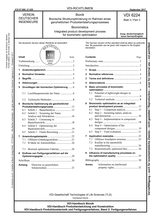Standards Worldwide
Standards Worldwide
Phone +49 30 58885700-07

Technical rule [CURRENT]
VDI 6224 Blatt 3:2017-09
Biomimetics - Integrated product development process for biomimetic optimisation
- German title
- Bionik - Bionische Strukturoptimierung im Rahmen eines ganzheitlichen Produktentstehungsprozesses
- Publication date
- 2017-09
- Original language
- German, English
- Pages
- 32
- Publication date
- 2017-09
- Original language
- German, English
- Pages
- 32
Product information on this site:
Quick delivery via download or delivery service
Buy securely with a credit card or pay upon receipt of invoice
All transactions are encrypted
Short description
The standard defines a systematic product development process to be used to develop and optimise lightweight structures for technical components. It consists of the consecutive work steps of technical description, screening of natural archetypes, bio-inspired concept development, technical concept optimisation and final validation. The process makes use of the lightweight potential and biodiversity of natural archetypes and combines them with the principles of evolution and natural growth. The standard instances the ELiSE process as an example of a systematic product development process in the field of structural lightweight design. The basic principle of the described process can be transferred from structural lightweight design to other technical fields. The standard focuses the demands of structural lightweight design regarding the optimisation of the structure by increasing stiffness and minimising stresses. This means that components, which are developed using the process, consider all manufacturing restrictions and technical boundary conditions and can bear all defined loads with a minimal use of material. At the same time, the design of the product guarantees a homogeneous stress distribution. Central loads are static and dynamic forces and crash load cases. The users of the standard will be able to apply biomimetic optimisation methods as efficient tools for the increase of the lifetime or the reduction of the weight of lightweight components. The standard addresses engineers of different fields of industries in their function as project manager, product developer, process optimiser, designer or calculation engineer and all those who are put in charge of the development and optimisation of lightweight components.
Content
ICS
07.080,
21.020
Also available in
Loading recommended items...
Loading recommended items...
Loading recommended items...
